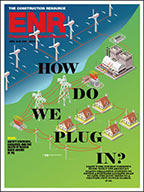...higher-than-expected concentrations of red-throated diver birds wintering in the area, says Rigg. Before allowing the full 1,000 MW to go ahead, authorities confined construction to 630 MW in the south to see how the birds would react.
London Array also has run into financial troubles, which climaxed two years ago, when investor London-based Shell Wind Energy Ltd. quit the project. Abu Dhabi Future Energy Co. (also known as Masdar) stepped in and now owns 20% of the project. Denmark’s Dong Energy A.S. has 50%, and Germany’s E.ON Climate & Renewables holds the balance.
By the time financing was secured, in late 2008, the global economic crisis hit, and the project’s prospects plummeted with the value of the British pound. With imports from continental Europe accounting for nearly 90% of the procurement, costs soared. “The bids … cast serious doubt on the viability of the project,” says Rigg.
Thirteen months ago, the government rescued LAL—and other similar projects—by boosting the cash value of their electrical output. The government increased their eligibility for Renewables Obligation Certificates (ROC) from 1.5 to 2 for each MW generated.
ROCs are bought from the generators by suppliers to demonstrate they are sourcing at least the mandatory minimum proportion of their electricity from renewables. The minimum is now around 10%, rising to 15.4% in five years. ROCs recently traded for about $65 each.
The turbine contract is LAL’s largest, accounting for about half the total investment. The 175 machines are among 500 ordered early last year from Siemens Wind Power A/S, Brande, Denmark, by Dong for this and other projects. “[It] is the biggest serial production offshore turbine in the world,” says Niels Bjaert, Siemens’ senior project manager, referring to the 3.6-MW machine.
Siemens will produce the generating equipment at two plants in Denmark. Its subcontractors around Europe will supply the 68-m-tall towers. Bjaert expects, next summer, to start delivering turbines to Denmark’s port at Esbjerg to be collected by ABJV.
The fabrication of the monopiles and TPs will be undertaken by ABJV’s subcontractor, Denmark’s Bladt Industries A/S, and its German joint-venture partner, EEW GmbH.
ABJV will hire barges to deliver all these items to the site. But LAL will charter and provide, at no charge, two jack-up vessels for ABJV’s installation work. The larger, self-powered “MPI Adventure” is being built in China for the job.
By procuring installation vessels and bulk-buying turbines, the massive offshore project has sidestepped supply bottlenecks that have threatened other offshore developments. “Just a couple of years ago, it was a seller’s market,” concedes Bjaert, referring to Siemens’ then offshore dominance. “Now [with competition growing] the trend is more in the direction of a buyer’s market.”



